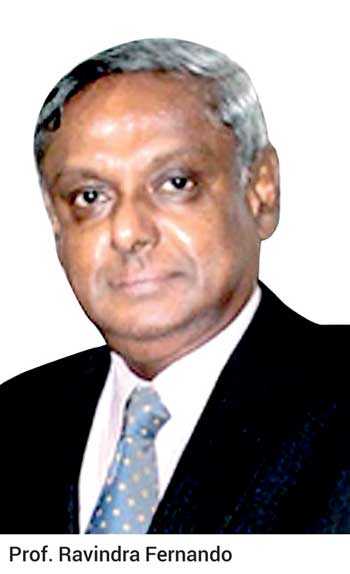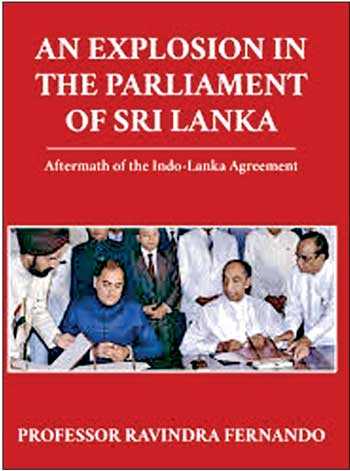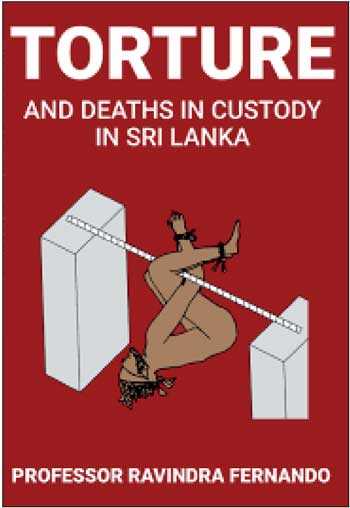Tuesday Apr 22, 2025
Tuesday Apr 22, 2025
Monday, 9 September 2019 00:25 - - {{hitsCtrl.values.hits}}
A notorious writer
Perhaps, it is only the LSE based economics don – the late Harry G. Johnson – who might have beaten Ravindra Fernando, emeritus professor of forensic medicine and toxicology of the Colombo Medical School, off his book publishing track. Johnson was famous for completing a scholarly article or a book, while crossing the Atlantic on a plane. Not to be outdone, Ravindra Fernando has also earned fame for publishing several books in a row.
It was only three months ago that he released a well-documented book titled ‘The Fifty Two Day Saga’ covering the infamous constitutional coup that shook the foundation of the country’s much cherished democratic heritage. That was his 25th publication. Even before that book had made its way fully to the market, he has now released two more books.
One titled ‘An Explosion in the Parliament of Sri Lanka: Aftermath of the Indo-Lanka Agreement’ has dealt with the assassination attempt on President JR Jayewardene two weeks after he had inked an agreement with India to resolve Sri Lanka’s festering civil war. The other is on torture and death in custody in Sri Lanka. Compared to his other books, these two books are smaller in size but in no way depleted with richness in stuff.

The tradition of giving a full story
Ravindra has been a fine writer who can present hard science in simple language to his readers. His objective has been to educate readers of complex forensic examination techniques used in solving crimes that have been for long in public’s vivid image due to their particular sensational appeal. Hence, the stories related by him are not limited only to the crime scene at hand. He gives the full story, what happened before, how the crime was committed and where it led subsequently. His previous books on such leading stories as the Sathasivam Murder Case, Mathew Peiris Case, Wijedasa Liyanarachchi Case, Lalith Athulathmudali Assassination Case, to mention but a few, are all written in this literary tradition. The present two books are not an exception.
An armed wing that can hit anyone at any place
Hence, An Explosion in Parliament is a refreshing course for those whose memories may now have somewhat faded. It is a learning course for those who have been born after this incident. Ravindra presents the case without taking a side and allows his readers to make judgment. But, though Ravindra has not said so, it is a testimony to the enormous power which a particular military arm of a proscribed political party had wielded in the country to attack anyone in any place of their choice.
If they can plan and stage an attack on Parliament, the most secured public institution at a time when the Head of the State was having a meeting with his Cabinet and Parliamentary colleagues, there is no more evidence needed to prove this point. It is a serious breach of security through which the lone attacker involved had carried out his deadly plan.
Choosing India by compulsion
The story as presented by Ravindra takes us back to the signing of the Indo-Lanka Peace Agreement between Sri Lanka’s President JR Jayewardene and India’s Prime Minister Rajiv Gandhi on 29 July 1987 in Colombo. JR had been forced to go for this option by India itself.
A few months ago, when Sri Lankan army had been moving forward steadily in its final assault in recapturing the LTTE stronghold Vadamarachchi, India scuttled the move by pronouncing the onset of a humanitarian crisis and the need for providing help to those who lived in that area. Thus, for the first time, Sri Lanka’s air space was invaded by its neighbour in the name of providing humanitarian assistance that consisted of dropping some food parcels for use by people in Jaffna.
That was not much relief but only a symbolic gesture that India was with them. When humiliated JR asked for support, his friends in the West looked the other way, while India’s military rival Pakistan made some sympathetic remarks.
If they can plan and stage an attack on Parliament, the most secured public institution at a time when the Head of the State was having a meeting with his Cabinet and Parliamentary colleagues, there is no more evidence needed to prove this point. It is a serious breach of security through which the lone attacker involved had carried out his deadly plan
The message conveyed by the global community was very clear to JR: Go back to India and settle your problems with them. Hence, when the country was burning due to the violent protests by the opposition and when a half of his Cabinet including his Prime Minister R. Premadasa had boycotted the signing ceremony, JR inked the agreement with Rajiv after placing the country under an indefinite curfew. Sri Lankans could witness it only on television.
JR’s choice here would have been that of a Devil’s alternative in which whatever he did, it caused deaths to people. An unfortunate incident that had occurred after the ceremony was the attack by a naval rating with the butt of his rifle when Rajiv was receiving a guard of honour. Fortunately, he was not injured but it was an inerasable black mark for both Indian and Sri Lankan leaders.

JR’s clarion call for Indian army on Sri Lanka’s soil
On the same night, Indian army had landed in Jaffna. According to Ravindra, it had been a decision which Rajiv had taken by himself without even consulting his Cabinet. As Rajiv had related it to one of his State Ministers later, the decision had been taken hurriedly in answering a ‘clarion call’ by JR that he was facing a military coup that night. The presence of Indian army on the soil of Sri Lanka had apparently forced the alleged coup perpetrators to change their mind. With India’s overt support for JR at that stage, no coup against him would have succeeded.
A chaotic situation
The country was in utter chaos in the two weeks following the signing ceremony. There was an open hostility against UNP and its leadership in the country. A new movement called the Patriotic People’s Movement had just sprung up to capitalise on the public resent against the Indo-Lanka Peace Agreement. It called for an open uprising and promised to give leadership to people in the event they would do so. It appeared that Sri Lanka was just drifting without a government at the centre. It is in this background that JR had chosen to address his Parliamentary group in Parliament. It is this meeting which had been chosen by the lone attacker to carry out his plan. As Ravindra has explained it, it is just by bad luck that he had failed to attain his goal of assassinating both the President and the Prime Minister together with the front runners in the Cabinet in a single attack.
“We’re being bombed”
The meeting in question had been convened in Committee Room A of the Parliamentary Building on that fateful day. Ravindra has explained in vivid detail how the members were seated, how the meeting commenced, how the attack was carried out and how the members responded to the melee that followed.
There have been some instances of cruel play of fate on some members present. For instance, Lalith Athulathmudali, Minster of National Security, had walked to the meeting late and found his usual seat on the left hand side had been occupied. Hence, he had moved to the right hand side and occupied a seat offered to him by another Cabinet colleague. Keerthi Abeywickrema, District Minister of Matara who had been seated in the back had moved to the chair behind Lalith to discuss some security issue with the Minister.
Ravindra has been a fine writer who can present hard science in simple language to his readers. His objective has been to educate readers of complex forensic examination techniques used in solving crimes that have been for long in public’s vivid image due to their particular sensational appeal. Hence, the stories related by him are not limited only to the crime scene at hand. He gives the full story, what happened before, how the crime was committed and where it led subsequently
The Parliamentary Official Norbert Senadheera had walked to the Committee Room with some documents to be handed to Prime Minster and was bending at the head table.
Then, a door to a room to the right of the place where the President had been seated at the head table was opened. Before anyone could gauge what was happening, some object was hurled at the President and it bounced off the table on to the floor. Then, it exploded filling the room with dark smoke and shooting shrapnel in all directions. Then, it was followed by another object being hurled from the same open door and it too exploded. Says Ravindra: it had thrown Parliamentarians into panic, screaming and yelling “We’re being bombed”.
Rising to the need
According to Ravindra, Parliamentarians had responded in the way they should do in an emergency. Those who had not been injured had been quick to pick up the injured and rush them out of the Committee Room into the waiting vehicles out there at the entrance. Lalith had been severely injured and not even winking his eyes. It was Ranjith Atapattu, who was himself a medical doctor and Minister of Health at that time, who had carried Lalith to Sri Jayewardenepura Hospital for emergency treatment. Had that decision being delayed for another five minutes, Lalith would have succumbed to his injuries. 
JR had been shouting at Parliamentarians who had been pointing at the blood strains on his shirt that it was not his blood but someone else’s. His appeal had been that not to worry about him but to attend to other’s needs. Prime Minister Premadasa, man courage, had walked to the Library by himself despite an injury to the knee and attended to his own first-aid. Gamini Lokuge had broken a glass window to enable some of the Parliamentarians to get out of the room. Such was the confused state in the Committee Room A immediately after the explosion.
Two fatalities
There were two fatalities. One was Keerthi Abeywickrema, District Minster for Matara, who had moved from the back of the room to the front to speak with Lalith. The other was the Parliamentary Official, Norbert Senadheera. Both of them had succumbed to their injuries at the National Hospital a few days later. With respect to Senadheera, the post mortem examination had been conducted by Ravindra. He had documented in minute detail the steps that had been adopted from A to Z. These details should definitely serve as a learning guide for upcoming students in forensic medicine.
Zeroing on Ajith Kumara
The CID which had conducted the investigations with support from detectives from the Scotland Yard had eliminated previous suspects one by one and zeroed on one Ajith Kumara, a minor employee in Parliament. He was missing from Parliament as well as from his residence adding further fuel to that suspicion. His wife and son also had disappeared from where they were living. Hence, IGP Frank de Silva had to announce the award of a prize of Rs. 1 million to anyone who would give a genuine tip for his arrest.
Then, a Police party from Naula Police in Matale District that had raided an illicit distillery in the jungle had quite accidentally arrested Ajith Kumara when he was trying to flee with his family on seeing the approaching policemen. That had provided a major breakthrough to the Police investigations.

Inadmissibility of involuntary confessions as evidence
Ravindra has then given full details of the trial that had been heard before a special Trial-at-Bar. There had been five accused with Ajith Kumara as the first. Demonstrating the seriousness of the case, the Prosecution was led by the Attorney-General himself with support from the second and the third layers of his Department. More than 100 witnesses had given evidence. But the contentious issue at the trial was whether a confession given by an accused to Police could be admitted as evidence.
An Explosion in Parliament is a refreshing course for those whose memories may now have somewhat faded. It is a learning course for those who have been born after this incident. Ravindra presents the case without taking a side and allows his readers to make judgment. But, though Ravindra has not said so, it is a testimony to the enormous power which a particular military arm of a proscribed political party had wielded in the country to attack anyone in any place of their choice
The lawyers for Ajith Kumara had argued that those confessions had not been made voluntarily but extracted from him by employing force. A Voir Dire inquiry was held in order to determine whether the confessions in question were admissible as evidence. It was the ruling of the Trial-at-Bar that they had not been made voluntarily and therefore were not admissible as evidence. From that point onward, the trial had collapsed. Finally, the Trial-at–Bar delivered its judgment that the prosecution had failed to prove the charges beyond doubt. Hence, all the five accused were acquitted. The Attorney General appealed to the Supreme Court against the verdict, but the Supreme Court too upheld it. Finally, Ajith Kumara and others became free men.
It provided ample proof that the country’s judicial system at that time was independent from the executive branch of the government.
Politics makes strange bedfellows
What happened to Ajith Kumara since then has also been documented by Ravindra. He had contested on JVP ticket for the post of Chief Minister of Sabaragamuwa Province but failed to secure a win. He had done JVP politics for some time but had broken away from the party alleging that it was not a true Marxist party. Then, he had started supporting UNP proving the adage that politics makes strange bedfellows. He had been a fiery critic of JVP at UNP meetings when its top leaders were present on the stage.
His wife and son had been killed by some unknown persons earlier. He had also admitted to a media person in an interview that he also had been a target by some unknown parties. All of a sudden he had disappeared from the political radar. When Ravindra had tried to contact him for an interview for his book, he had been told that Ajith Kumara was living now in USA.
This review has been confined only to his book covering the explosion in Parliament. But, both books he has published are worthy of reading. The readers can attune themselves to the special art which Ravindra displays in writing making them his intellectual partners.
(The writer, a former Deputy Governor of the Central Bank of Sri Lanka, can be reached at [email protected].)
Discover Kapruka, the leading online shopping platform in Sri Lanka, where you can conveniently send Gifts and Flowers to your loved ones for any event including Valentine ’s Day. Explore a wide range of popular Shopping Categories on Kapruka, including Toys, Groceries, Electronics, Birthday Cakes, Fruits, Chocolates, Flower Bouquets, Clothing, Watches, Lingerie, Gift Sets and Jewellery. Also if you’re interested in selling with Kapruka, Partner Central by Kapruka is the best solution to start with. Moreover, through Kapruka Global Shop, you can also enjoy the convenience of purchasing products from renowned platforms like Amazon and eBay and have them delivered to Sri Lanka.
Discover Kapruka, the leading online shopping platform in Sri Lanka, where you can conveniently send Gifts and Flowers to your loved ones for any event including Valentine ’s Day. Explore a wide range of popular Shopping Categories on Kapruka, including Toys, Groceries, Electronics, Birthday Cakes, Fruits, Chocolates, Flower Bouquets, Clothing, Watches, Lingerie, Gift Sets and Jewellery. Also if you’re interested in selling with Kapruka, Partner Central by Kapruka is the best solution to start with. Moreover, through Kapruka Global Shop, you can also enjoy the convenience of purchasing products from renowned platforms like Amazon and eBay and have them delivered to Sri Lanka.